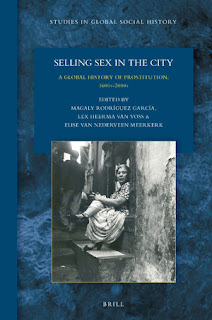Urban pleasure guides
Where to go for a night in town? In nineteenth-century Amsterdam leaflets with tips on where one could have a 'peek at lady servants' or meet "greek nymphs" were handed out on the streets.(1) In other metropolia, newsstands offered pocketbooks with addresses and reviews of local brothels and prostitutes. The old guides are still popular. In 2020 The pretty women of Paris, printed in 1883, was sold for 6.000 dollars at an auction. For historians, these urban pleasure guides are interesting resources. Not because the given reviews provide new insights into what men considered important qualities of 'women of the night'. Those remarks have not changed much during the centuries. What is of interest is where public women and houses were located in a metropolis, the prices of services and descriptions of establishments. Fortunately, the originals can still be viewed in libraries or online and contemporary reprints can be bought at reasonable prices.(2)
The rareness of nineteenth-century pleasure guides becomes apparent when you consult the register of erotic books by Alfred Rose.(3) His summing-up also reveals that these types of books were not invented by Victorians. Harris's List of Covent Garden Ladies was, for instance, published annually from 1757 to 1795 and Les bordelles de Paris, avec less noms, demeurs et prix was printed in 1790.(4) Well-known guides in the nineteenth century were:
- London: The New Swell's Night Guide (1830s-1840s)
- London: The man of pleasure pocketbook (1850)
- New York: The Gentleman's directory (1870)
- Brussels/Paris: Paris and Brussels after dark. The Gentleman's night guide (1883).
The pretty women of Paris (1883)
I recently bought the 1996 reprint of The pretty women of Paris. It contains:
- 250 women, ordered alphabetically on their [last] name with the addresses where the author met them and a review on each of them,
- 99 addresses of licensed brothels in Paris during that time, including the arrondissement,
- comments on eight licensed establishments,
- 11 licensed brothels in the suburbs of Paris.
My first assumption that the listed women were probably living in one of the licensed brothels turned out to be false. The addresses of the women were different from those of the licensed public houses. Since prostitutes working in brothels did usually not go out to pick up clients, the women mentioned in the guide had to be self-employed or working clandestinely.
 |
| Arrondissements Paris CharlieFilm, Wikipedia Commons, CC BY-SA 4.0 |
What can the guide reveal on where to find prostitution in Paris? Most licensed brothels (20%) were located in the city centre within the second arrondissement. The guide describes a very luxurious establishment there, aimed at the upper 10, and well to do ladies as customers.
"Each room is decorated in a different style, regardless of expense.[...] The management issues an illustrated book giving a view of the principal saloons" [p. 186]
With the use of a bathing chamber, prices in this luxurious place would go up to a hundred francs. But not only expensive establishments were mentioned in the guide. A brothel in the nearby 9th arrondissement is recommended for its excessive cheapness. The fee for entrance was five francs added with a few more for the services of the prostitute.
The list containing the self-employed, clandestine women, shows that most of them were or had been working in the growing entertainment industry as actresses, dancers or singers. Quite a number of their corresponding addresses in the directory were theatres, like the Gymnase Theatre and Nouveautes Theatre. Overall these women were located in the north-western arrondissements of Paris (arrondissements 8, 9, 17).
Stay critical
Old urban pleasure guides can offer interesting information on prostitution within a city. But focussing only on this resource would give a one-dimensional view of the topic. It is therefore vital to compare it to other archival resources and put it in context. Relevant critical questions are:
- what are other archival resources that either confirm, add or give a different view on the topic?
- what can we find out about the author who wrote the guide and is usually called: "anonymous"?
- in what context can we place the information?
A reprint version of a guide can offer extra information because it often contains an added introduction where more is revealed about the origin and content of the publication. The introduction of The pretty women has been written by antiquarian Robin de Beaumont. He states that the anonymous author was probably English and was helped by others, "for how could one man discover so much?"[p.8] This last assumption could be the case, although, on the other hand, a lot of the mentioned women had similar addresses or lived in the same neighbourhood.
In short. Pleasure guides can offer important new historical insights. But should be handled with care and a critical stare.
Notes
(1) J.F. Slobbe, Bijdrage tot de geschiedenis en de bestrijding der prostitutie te Amsterdam (Amsterdam 1936) 94 and view my Dutch post: Prostitutie in de kroeg
(2) Second-hand reprints can be found on for instance: NY Historical Society, Gentleman's Directory - Applewood After Dark (Reprint from 1870; NY 2013).
(3) Alfred Rose, Register of erotic books (New York 1965).
(4) See the extensive lemma on Harris's List on Wikipedia: https://en.wikipedia.org/wiki/Harris's_List_of_Covent_Garden_Ladies (visited 09-04-2022) The link to Harris List is the issue of 1888 available via Internet Archive.
(5) See for instance: López Galviz, Carlos, Cities, Railways, Modernities: London, Paris, and the Nineteenth Century (New York, NY 2019) 20. An interesting book on the entertainment history of London is: Rohan McWilliam, London's West End: Creating the Pleasure District, 1800-1914 (London 2020).




Comments
Post a Comment